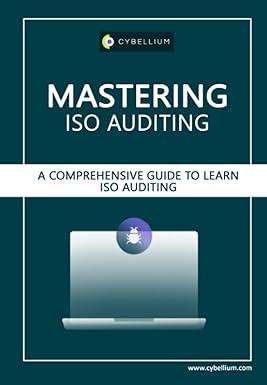Question
Plantwide Overhead Rate versus Departmental Rates, Effects on Pricing Decisions Cherise Ortega, marketing manager for Romer Company, was puzzled by the outcome of two recent
Plantwide Overhead Rate versus Departmental Rates, Effects on Pricing Decisions
Cherise Ortega, marketing manager for Romer Company, was puzzled by the outcome of two recent bids. The company's policy was to bid 150 percent of the full manufacturing cost. One job (labeled Job 97-28) had been turned down by a prospective customer, who had indicated that the proposed price was $3 per unit higher than the winning bid. A second job (Job 97-35) had been accepted by a customer, who was amazed that Romer could offer such favorable terms. This customer revealed that Romer's price was $43 per unit lower than the next lowest bid.
Cherise has been informed that the company was more than competitive in terms of cost control. Accordingly, she began to suspect that the problem was related to cost assignment procedures. Upon investigating, Cherise was told that the company uses a plantwide overhead rate based on direct labor hours. The rate is computed at the beginning of the year using budgeted data. Selected budgeted data are given below.
| Department A | Department B | Total | |||||
| Overhead | $500,000 | $2,000,000 | $2,500,000 | ||||
| Direct labor hours | 200,000 | 50,000 | 250,000 | ||||
| Machine hours | 20,000 | 120,000 | 140,000 |
Cherise also discovered that the overhead costs in Department B were higher than those in Department A because B has more equipment, higher maintenance, higher power consumption, higher depreciation, and higher setup costs. In addition to the general procedures for assigning overhead costs, Cherise was supplied with the following specific manufacturing data on Jobs 97-28 and 97-35:
| Job 97-28 | |||||||
| Department A | Department B | Total | |||||
| Direct labor hours | 5,000 | 1,000 | 6,000 | ||||
| Machine hours | 200 | 500 | 700 | ||||
| Prime costs | $100,000 | $20,000 | $120,000 | ||||
| Units produced | 14,400 | 14,400 | 14,400 | ||||
| Job 97-35 | |||||||
| Department A | Department B | Total | |||||
| Direct labor hours | 400 | 600 | 1,000 | ||||
| Machine hours | 200 | 3,000 | 3,200 | ||||
| Prime costs | $10,000 | $40,000 | $50,000 | ||||
| Units produced | 1,500 | 1,500 | 1,500 | ||||
Required:
1. Using a plantwide overhead rate based on direct labor hours, develop the bid prices for Jobs 97-28 and 97-35 (express the bid prices on a per-unit basis). If required, round your answers to the nearest cent.
| Unit bid price | |
| Job 97-28 | $ |
| Job 97-35 | $ |
2. Using departmental overhead rates (use direct labor hours for Department A and machine hours for Department B), develop per-unit bid prices for Jobs 97-28 and 97-35. If required, round intermediate computations and final answers to the nearest cent.
| Unit bid price | |
| Job 97-28 | $ |
| Job 97-35 | $ |
3. Compute the difference in gross profit that would have been earned had the company used departmental rates in its bids instead of the plantwide rate. Round your intermediate computations to two decimal places and final answer to the nearest dollar. Gross profit would have increased by $
Feedback
1. Plantwide OH rate is based on total estimated Overhead and total estimated driver. After you determine the bid price remember to express it in per-unit basis.
2. Departmental OH rate is based on the individual department estimates and the chosen driver.
Step by Step Solution
There are 3 Steps involved in it
Step: 1

Get Instant Access to Expert-Tailored Solutions
See step-by-step solutions with expert insights and AI powered tools for academic success
Step: 2

Step: 3

Ace Your Homework with AI
Get the answers you need in no time with our AI-driven, step-by-step assistance
Get Started


